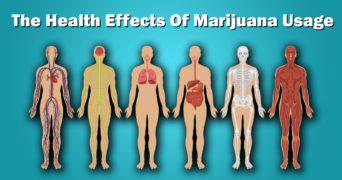As the conversation around cannabis continues to evolve, medical research is delving deeper into its effects, both beneficial and otherwise. Among the many forms of consumption that have emerged, the intriguing concept of “marijuana-infused” products is captivating a diverse audience. One such product garnering attention is marijuana, often linked to relaxation and relief, but its implications remain complex. The Mayo Clinic, a trusted authority in healthcare, provides valuable insights into the side effects associated with marijuana use. In this article, we will explore the findings presented by the Mayo Clinic, shedding light on both the potential risks and benefits of cannabis consumption, guiding readers through the intricate landscape of this widely discussed substance. Join us as we dissect the nuances of marijuana’s impact on health and well-being, aiming for a balanced understanding of this controversial topic.
Table of Contents
- Understanding the Potential Side Effects of Marijuana Use
- Exploring the Impact of Marijuana on Mental Health
- Navigating the Risks: Marijuana and Physical Well-being
- Recommendations for Responsible Use in Therapeutic Contexts
- Q&A
- Wrapping Up
Understanding the Potential Side Effects of Marijuana Use
While many users turn to marijuana for its potential therapeutic benefits, it’s crucial to be aware of the side effects that can accompany its use. Common reactions can include short-term memory impairment, altered judgment, and coordination issues. These side effects are particularly pronounced during the initial phases of consumption and can impact daily activities, such as driving or operating machinery. Additionally, feelings of anxiety, paranoia, or changes in mood may arise, complicating an individual’s experience and perception. Regular users should remain mindful of these effects, as they can differ greatly based on dosage, method of consumption, and individual tolerance.
Long-term marijuana use may also lead to more serious consequences. Research suggests a possible connection between chronic usage and respiratory problems, especially if the marijuana is smoked. Furthermore, prolonged exposure can result in cognitive decline, impacting attention span and memory retention over time. This is particularly important for adolescents, as their developing brains may be more vulnerable. Below is a concise overview of some notable potential side effects categorized by usage duration:
| Duration of Use | Potential Side Effects |
|---|---|
| Short-term |
|
| Long-term |
|
Exploring the Impact of Marijuana on Mental Health
The relationship between marijuana and mental health is a complex one, often resulting in a variety of psychological effects depending on individual circumstances. While some users report positive feelings of relaxation and calmness, others may experience adverse reactions that can exacerbate underlying mental health conditions. Understanding these potential outcomes is crucial for those considering marijuana for recreational or therapeutic purposes. Below are some of the effects to consider:
- Anxiety Reduction: In some cases, marijuana may provide temporary relief from anxiety.
- Heightened Anxiety or Paranoia: Conversely, certain strains or dosages can increase feelings of anxiety or provoke paranoia.
- Altered Perceptions: Marijuana can distort sensory perceptions, which may lead to mood changes.
- Impact on Motivation: Prolonged use may result in a decline in motivation and focus.
Furthermore, it’s essential to recognize the potential long-term effects that marijuana may have on mental health. Research suggests that heavy and prolonged use, particularly among young individuals, could be associated with increased risks of mental health disorders, including depression and schizophrenia. A summary of some long-term impacts is provided in the table below:
| Potential Long-Term Impacts | Associated Risks |
|---|---|
| Increased Depression | Higher rates of depressive episodes |
| Cognitive Impairment | Memory and learning difficulties |
| Psychotic Disorders | Potential onset in predisposed individuals |
| Withdrawal Symptoms | Mood swings, irritability |
Navigating the Risks: Marijuana and Physical Well-being
As the acceptance and use of marijuana continue to increase, understanding its impact on physical well-being becomes paramount. Users may experience a range of side effects that could influence their overall health. Some common physical risks associated with marijuana use include:
- Respiratory Issues: Smoking marijuana can harm lung health, leading to chronic bronchitis and other respiratory problems.
- Cardiovascular Effects: The drug can increase heart rate and blood pressure, posing risks for individuals with underlying heart conditions.
- Neurological Changes: Regular use may affect coordination and reaction times, increasing the likelihood of accidents.
- Gastrointestinal Distress: Some users experience nausea or vomiting, which can lead to dehydration if severe.
Interestingly, marijuana also interacts with various conditions and medications, necessitating careful consideration. Understanding these interactions can help in making informed choices about use. A simple overview of potential medication interactions includes:
| Medication | Potential Interaction |
|---|---|
| Blood Thinners | May increase bleeding risk |
| Antidepressants | May alter effectiveness |
| Antiepileptics | Potential for decreased efficacy |
| Anti-inflammatory Drugs | May exacerbate gastrointestinal issues |
Recommendations for Responsible Use in Therapeutic Contexts
When considering the therapeutic use of marijuana, it is essential to approach its application thoughtfully and responsibly. Patients should prioritize open communication with healthcare providers to ensure that the treatment aligns with their health goals while minimizing potential risks. Here are some crucial points to consider:
- Consultation is Key: Always discuss with a qualified medical professional prior to starting any marijuana-based treatment.
- Start Low, Go Slow: Beginners should consider starting with small doses to monitor their body’s reactions and adjust accordingly.
- Be Aware of Interactions: Understand how marijuana might interact with any other medications you are taking.
- Monitor Effects: Keep a journal of your experiences to share with your healthcare provider, including any side effects or unexpected reactions.
Additionally, being informed about dosage forms, methods of consumption, and legal aspects is essential to safe use. Patients and caregivers should utilize resources and support systems that promote educated decision-making when it comes to marijuana. Below is a table highlighting different consumption methods along with their potential benefits and risks:
| Consumption Method | Benefits | Risks |
|---|---|---|
| Inhalation (smoking or vaping) | Rapid onset of effects | Respiratory issues, potential lung irritation |
| Edibles | Longer-lasting effects | Delays in onset can lead to overconsumption |
| Oils and Tinctures | Precise dosage control | Possible interaction with other medications |
Q&A
Q&A: Side Effects of Marijuana – Insights from the Mayo Clinic
Q1: What are the common side effects of marijuana use?
A1: Cannabis can have a variety of effects on the body and mind. Common side effects include dry mouth, red eyes, increased heart rate, and feelings of euphoria. However, users may also experience anxiety, paranoia, or cognitive impairments, especially with higher doses or more potent strains.
Q2: Are there any long-term effects of marijuana use?
A2: Long-term marijuana use has been associated with several potential issues, including respiratory problems (if smoked), dependence, and cognitive decline. Some studies suggest a link between prolonged use and mental health disorders, particularly in individuals predisposed to conditions like schizophrenia.
Q3: Is marijuana safe for medicinal use?
A3: For certain medical conditions, marijuana may be beneficial. Patients often find relief from symptoms of chronic pain, nausea from chemotherapy, or muscle spasms. Nonetheless, it’s crucial to discuss this treatment with healthcare professionals to weigh the potential benefits against the risks and side effects.
Q4: How does marijuana affect mental health?
A4: Marijuana can have varied effects on mental health. While some users report reduced anxiety and improved mood, others may experience heightened anxiety, paranoia, or psychosis, particularly with heavy use or in those with a personal or family history of mental illness.
Q5: Can marijuana impact driving ability?
A5: Yes, marijuana can impair driving capabilities. It affects coordination, reaction times, and judgment, increasing the risk of accidents. Users are advised to refrain from driving after using marijuana to ensure their safety and the safety of others.
Q6: What should I know about marijuana interactions with other medications?
A6: Marijuana may interact with various medications, potentially altering their effects. For instance, it can impact blood pressure medications and anticoagulants. It’s essential to consult a healthcare provider to discuss any current medications before using marijuana.
Q7: Are there specific populations more at risk for adverse effects?
A7: Yes, certain groups may be more vulnerable to the adverse effects of marijuana. This includes adolescents, pregnant individuals, and those with a history of mental health issues. For these populations, the risks may outweigh potential benefits, making professional guidance crucial.
Q8: How can individuals mitigate the risks associated with marijuana use?
A8: To mitigate risks, individuals can start with low doses, choose strains with balanced THC and CBD ratios, and be aware of their own tolerance levels and mental health. Additionally, consuming marijuana in a safe environment and avoiding concurrent use with other substances can help reduce adverse reactions.
Q9: Where can I find more information on marijuana and its effects?
A9: For robust information, resources like the Mayo Clinic’s website, academic journals, and consultations with medical professionals provide credible insights. Staying informed is key to making educated decisions regarding marijuana use and understanding its potential effects on health.
Wrapping Up
while the therapeutic potential of marijuana continues to be a subject of vibrant discussion, it’s essential to approach its use with informed caution. The Mayo Clinic highlights various side effects that accompany marijuana use, emphasizing the importance of understanding both its benefits and risks. Whether exploring it for medicinal purposes or personal wellness, staying informed enables users to engage with marijuana responsibly. As research evolves, so too will our understanding of its impacts on health. Always consult healthcare professionals to navigate this complex landscape, ensuring that the journey with marijuana is not only safe but also aligned with your individual health needs.



